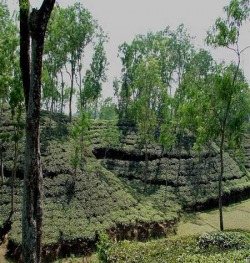Refer from Banglavasha.com
Old High Court, Dhaka

High Court Building (Old) a colonial building in Dhaka situated on Qazi Nazrul Islam Avenue, opposite the picturesque curzon hall, and skirting the Ramna Green. This imposing two-storeyed edifice was originally designed as the official residence of the governor of the newly created province of East Bengal and Assam in the wake of the partition of bengal (1905). On completion of the building, the consulting architect of the government of India considered it unbefitting a governor's residence and therefore it remained vacant. Later it housed the Dhaka Intermediate College and still later, in erstwhile East Pakistan, it was converted into the High Court.
Srimongal

Srimongal is the place of tea gardens, hills and forest areas on the hills. Within your eyesight you will find green throughout. Its is famous for the largest tea gardens of world covered by lush green carpet. One can have a look into the spectacular tea processing at Tea Research Institute.
National Martyrs Memorial

National Martyrs Memorial is situated in Nabinagar, Savar approximately 35 km from Dhaka. The memorial designed by architect Moinul Hossain is dedicated to the sacred memory of the millions of unknown martyrs of the war of liberation. This Martyrs Memorial is a symbol of Bengali nationalism. It is really a scenic beauty of 108 acre of land.
Baitul Mukarram Mosque

Baitul Mukarram Mosque is situated at Purana Paltan east of Bangladesh Secretariat and north of Dhaka Stadium. Largest Mosque in the city, three storied and built after the pattern of the Kaba Sharif. Very beautiful and costly decorations in the interior. Long lawn, garden and rows of fountains to the south and east.
Bandarban

Lots of hills and hilly areas, waterfalls, River Sangu, Lakes and the tribal culture are the main attraction of Bandarban .You can go to Bandarban from Chittagong by road. Chimbuk hill is one of the major attractions of Bandarban. You can enjoy the journey to Chimbuk Hill by jig jag hilly roads.
Bhasu Vihara

Bhasu Vihara Located at about 6 km west of mahasthangarh (Mahasthangad) on the northern part of village Bhasu Vihara, under Bihar union of Shibganj thana of Bogra district, about 500m west of the Nagar river. Three mounds have been excavated here revealing the basal parts of two monasteries and one shrine. Bhasu Vihara, locally known as Narapatir Dhap, is a complex of two rectangular monasteries and a semi-cruciform shrine of the Post-Gupta period. Monastery 1 Built of burnt bricks set in mud mortar, this was roughly rectangular in plan, measuring 148.
Rangpur Museum

Just south of the city of Rangpur lies the Tajhat, a former "rajbari" or zamindar's palace. After the end of the British Raj, the building was abandoned and decayed rapidly, although it was used for a few years as a courthouse during the 1980's. In the year 2004, it was largely restored and turned into a museum with ancient inscriptions, art and coins from the area on display.
National Museum

Bangladesh national museum is situated in shahbag. Located at the central point of the city. The museum contains a large number of interesting collections including sculptures and paintings of the Hindu, Buddhist and Muslim periods as well as inscriptions of the Holy Quran in Arabic and Persian letters and Bengali works in the Arabic script. The museum also has a rich collection of old coins, metal images, books on art, silver filigree works etc.
Khagrachhari

Khagrachhari is the natural wild beauty of Bangladesh. Here you can visit the tribal lifestyle of Chakmas in Khagrachari. You can also visit Alutila hill. Approximately 100 meters long a very dark Cave is the mysterious beauty of Alutila hill.
Shat Gambuj Mosque

In mid-15th century, a Muslim colony was founded in the inhospitable mangrove forest of the Sundarbans near the seacoast in the Bagerhat district by an obscure saint-General, named Ulugh Khan Jahan. He was the earliest torch bearer of Islam in the South who laid the nucleus of an affluent city during the reign of Sultan Nasiruddin Mahmud Shah (1442-59), then known as 'Khalifalabad' (present Bagerhat). Khan Jahan aborned his city with numerous mosques, tanks, roads and other public buildings, the spectacular ruins of which are focused around the most imposing and largest multidomed mosques in Bangladesh, known as the Shait-Gumbad Masjid (160'X108'). The stately fabric of the monument, serene and imposing, stands on the eastern bank of an unusually vast sweet-water tank, clustered around by the heavy foliage of a low-laying countryside, characteristic of a sea-coast landscape.
Refer from Banglavasha.com
